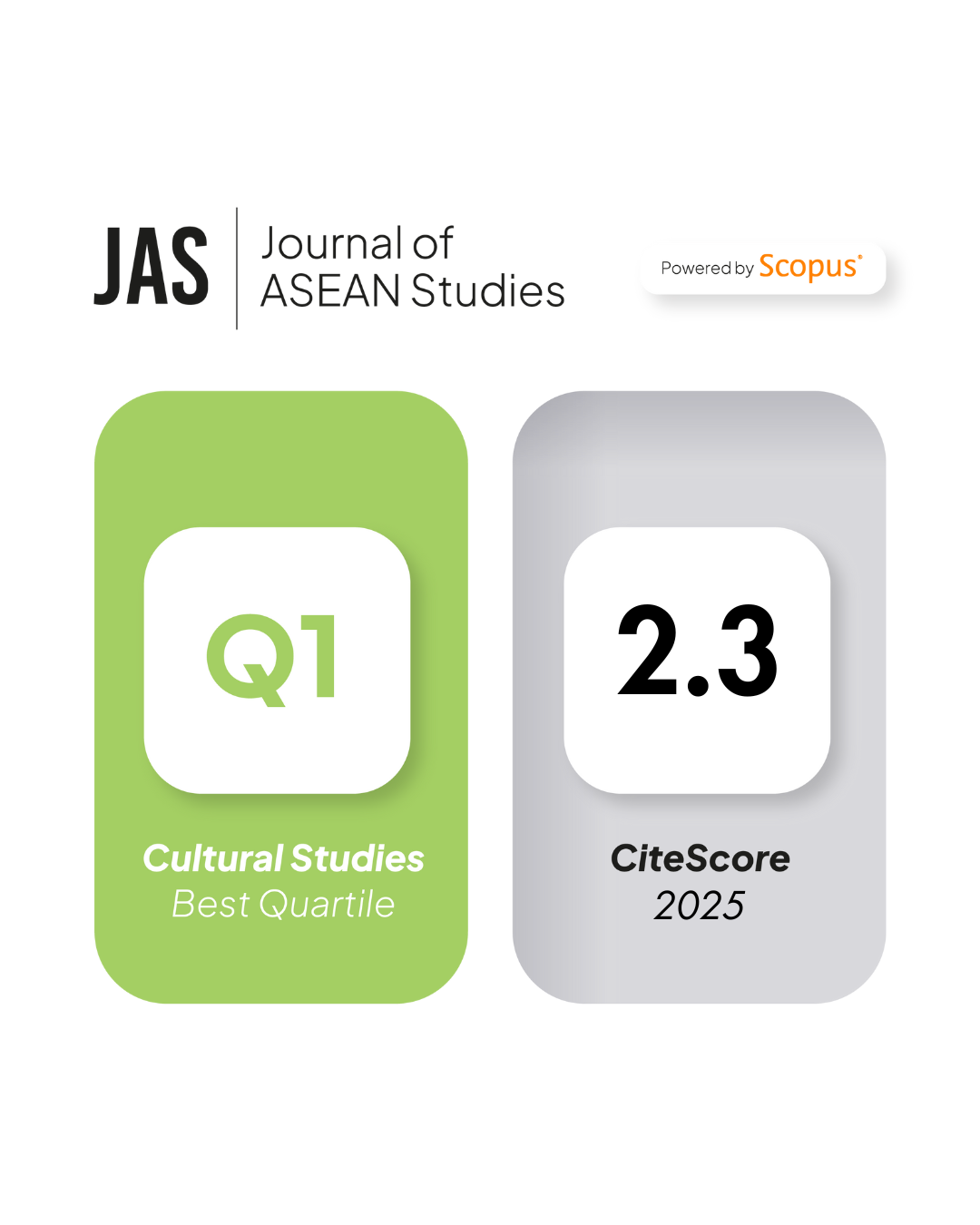The Key Factors of Economic Integration in Southeast Asia: Case of Indonesia, Malaysia, and Thailand
DOI:
https://doi.org/10.21512/jas.v4i2.887Keywords:
Economic Integration, International Investment (Long-Term Capital-FDI Inflows), ASEAN Free Trade Area (AFTA), Bilateral Free Trade Agreements (BFTA) and Asian Noodle-Bowl PhenomenonAbstract
Shifting from intra-regional trade to that of investment is the major aim of the economic integration of Southeast Asia. This article attempts to analyse the two essential factors of it, one is intra-regional trade and two is economic community. For the first analysis it selects Indonesia, Malaysia and Thailand as the observed countries and for the second analysis it takes Indonesia as the field study. Firstly, this article finds that free trade agreement is effective to increases intra-regional trade but ineffective to attract investment therefore Southeast Asia needs to amplify its open-regionalism principle. Secondly, it finds that private sector is ready towards the economic community therefore the ASEAN Economic Community is fit for the recent Southeast Asia’s integration.
References
Akamatsu, K (1944). Keisei Shinchitujo no Keisei Genli (The Theory of Formation of the New Economic Order). Tokyo: Lisosha.
ASEAN Secretariat (1999). ASEAN Investment Area: Temporary Exclusion List and Sensitive List. Jakarta: The ASEAN Secretariat.
Baldwin, R.E (2006). Managing the Noodle Bowl: The Fragility of East Asian Regionalism. CEPR Discussion Paper No.5561. London.
Baltagi, B.H., P. Egger and M. Pfaffermayr (2005). Estimating Regional Trade Agreement Effects on FDI in an Independent World.
Barrell, R. and N. Pain (1996). An Econometric Analysis of U.S. Foreign Direct Investment. The Review of Economics and Statistics, vol. 78, No. 2 (May), pp. 200-207.
Bowles, P and B.MacLean (1996). Understanding trade bloc formation: the case of the ASEAN Free Trade Area. Review of International Political Economy, vol.3, No.2 Summer, pp.319-348
Braga, P and G.Bannister (1994)..East Asian Investment and Trade: Prospects for Growing Regionalisation in 1990’s.Transnational Corporations, vol.3, No.1.
Dunning, J.H (1988). Explaining International Production. Londong: Unwin Hyman Ltd.
Dunning, J.H (1990).Economic Integration and Transatlantic Foreign Direct Investment: The Record Assessed. Discussion Papers in International Investment and Business Studies, Series B, no. 144, Department of Economics, University of Reading.
Foster, M. J (2000). Evaluating Foreign Direct Investments: New Challenges for Strategic Planners. The Journal of the Operational Research Society, vol. 51, No. 1 (January). Part Special Issue: OR and Strategy, pp. 45-52.
Frankel, J (1997). Regional Trading Blocs in the World Economic System.Institute for International Economics, Washington D.C.
Hayakawa, K. and F. Kimura (2008). The Effect of Exchange Rate Volatility on International Trade in East Asia (December). ERIA Discussion Paper Series.
Hayakawa, K., Hiratsuka, K. Shiino and S. Sukegawa (2009). Who Uses Free Trade Agreements? (November). ERIA Discussion Paper Series.
Hejazi, W. and A. E. Safarian (1999). Trade, Foreign Direct Investment, and R&D Spillovers.Journal of International Business Studies, vol. 30, No. 3 (3rd Qtr), pp. 491-511.
Hejazi, W. and P. Pauly (2003). Motivations for FDI and Domestic Capital Formation. Journal of International Business Studies.,vol. 34, No. 3 (May), pp. 282-289.
Helpman, E (1984). A Simple Theory of International Trade with Multinational Corporations. Journal of Political Economy. 92, pp. 451-472
Helpman, E., and P. Krugman (1985). Market Structure and Foreign Trade: Increasing Returns, Imperfect Competition and the International Economy, MIT Press, Cambridge, MA.
Kawai M and G.Wignaraja (2008). EAFTA or CEPEA: What Makes Sense? ASEAN Economic Bulletin,vol. 25, No.2, pp.113-139
Kiyota,K., and S. Urata (2004). Exchange Rate, Exchange Rate Volatility and Foreign Direct Investment. The World Economy, vol. 27, No.10, pp.1501-1536.
MacDermott, R (2006). Regional Trade Agreement and Foreign Direct Investment. The North American Journal of Economics and Finance, vol.18, pp. 107-116.
Markusen, J.R (1984). Multinationals, Multi-Plant Economies, and the Gains from Trade.Journal of International Economics 16, pp.205-226.
Menon, J (1996). The Dynamics of Intra-Industry Trade in ASEAN. Asian Economic Journal, vol.10, No.1.
Menon, J (2006). Bilateral Trade Agreements and World Trading System. ADB Institute Discussion Paper, ADBI (November).
Motta, M. and G. Norman (1996). Does Economic Integration Cause Foreign Direct Investment? International Economic Review, vol. 37, No. 4 (November), pp. 757-783
Nesadurai, H (2003). Globalization, Domestic Politics and Regionalism: the ASEAN Free Trade Area. London: Routledge.
Panagariya, A (2000). Preferential Trade Liberalization: The Traditional Theory and New Developments. Journal of Economic Literature, vol. 38, No.2, pp.287-331.
Ravenhill, J (1995). Economic Cooperation in Southeast Asia. The Regents. The University of California.
Sethi, D., S. E. Guisinger, S. E. Phelan, D. M. Berg (2003).Trends in Foreign Direct Investment Flows: A Theoretical and Empirical Analysis. Journal of International Business Studies, vol. 34, No. 4 (July), pp. 315-326.
Tumbarello, P (2007). Are Regional Trade Agreements in Asia Stumbling or Building Blocks? Implication for the Mekong-3 Countries, IMF Working Paper, WP/07/53, Washington D.C.: IMF
Urata, S (1993). Japanese Foreign Direct Investment and Its Effect on Foreign Trade in Asia. In Trade and Protection (eds T. Ho and
Krueger A.O.), pp.273-304. Chicago:University of Chicago Press.
Urata, S (2007). Competitive Regionalism in East Asia: An Economic Analysis. GIARI Working Paper, Waseda University, Tokyo.
Urata, S., and Okabe (2007) in Urata,Shujiro. Competitive Regionalism in East Asia: An Economic Analysis. GIARI Working Paper, 2007-E-2, December 2007, pp.20
Viner, J (1950). The Custom Union Issue. New York: Carnegie Endowment for International Peace.
Vogelvang, B (2005). Econometric:Theory and Applications with E-Views, (1st ed.). UK: Pearson Education Limited.
Walz, U (1997). Innovation, Foreign Direct Investment and Growth, Economica., new series, vol. 64, No. 253 (February), pp. 63-79.
Yoshimatsu, H (2002). Preferences, Interests and Regional Integration the Development of the ASEAN Industrial Cooperation Agreement. Review of International Political Economy, vol.9, No.1 (March), pp.123-149.






















